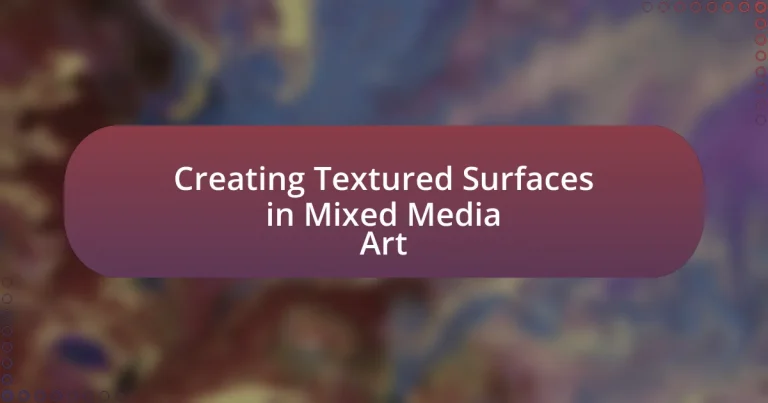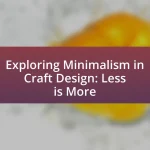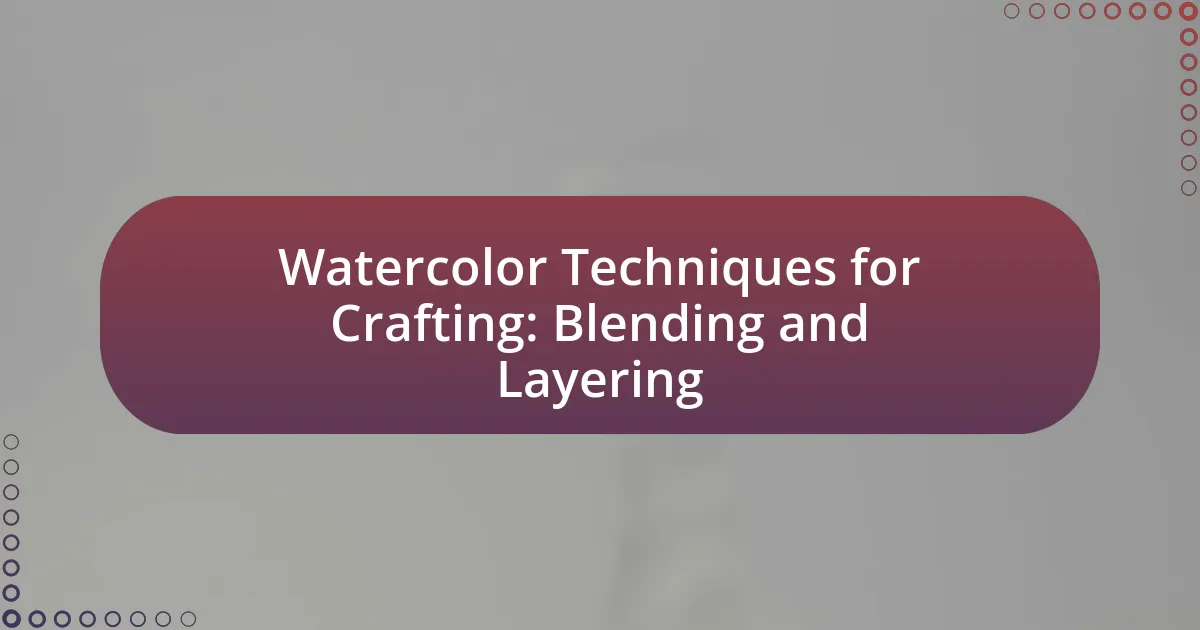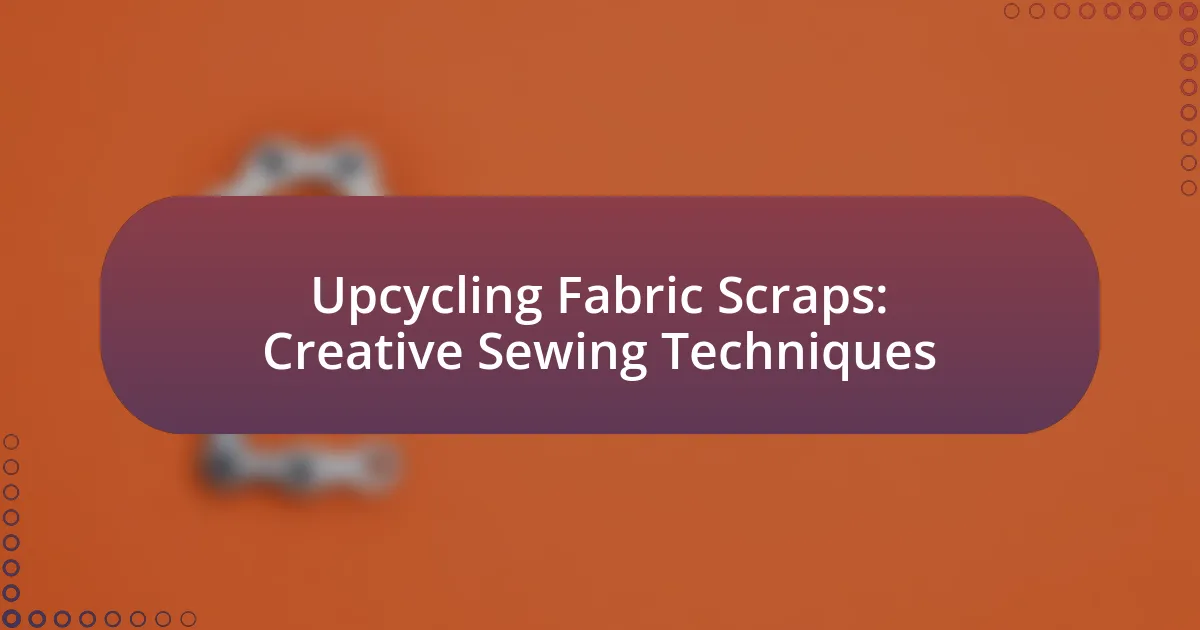Creating textured surfaces in mixed media art involves the combination of various materials and techniques to enhance the visual and tactile qualities of artwork. This article explores the significance of textured surfaces, detailing how they add depth, visual interest, and emotional resonance to mixed media pieces. Key techniques such as layering, impasto, and the incorporation of diverse materials like fabric and sand are discussed, along with the essential tools and supplies needed for texture creation. Additionally, the article examines how textures influence viewer perception and emotional responses, highlighting their importance in artistic expression and narrative development.

What are Textured Surfaces in Mixed Media Art?
Textured surfaces in mixed media art refer to the varied tactile qualities created by combining different materials and techniques within a single artwork. These surfaces can include elements such as paint, fabric, paper, and found objects, which are layered or applied to create depth and visual interest. The use of textured surfaces enhances the sensory experience of the artwork, allowing viewers to engage with it on multiple levels. Artists often employ techniques like collage, impasto, or the incorporation of three-dimensional elements to achieve these textures, which can evoke emotions and convey meaning more effectively than flat surfaces alone.
How do textured surfaces enhance mixed media artworks?
Textured surfaces enhance mixed media artworks by adding depth, visual interest, and tactile engagement. These surfaces create a dynamic interplay between different materials, allowing artists to explore contrasts in color, light, and form. For instance, the use of materials like sand, fabric, or paper can introduce varied textures that draw the viewer’s eye and invite touch, thereby enriching the overall sensory experience of the artwork. Textured surfaces also facilitate layering techniques, which can lead to more complex compositions and narratives within the piece.
What visual effects do textured surfaces create in art?
Textured surfaces in art create dynamic visual effects that enhance depth, interest, and tactile engagement. These surfaces can manipulate light and shadow, leading to varying perceptions of color and form, which can evoke emotional responses from viewers. For instance, rough textures may create a sense of ruggedness or chaos, while smooth textures can convey calmness or elegance. Research indicates that texture influences viewer perception and interaction, as demonstrated in studies where textured artworks elicited stronger emotional reactions compared to flat surfaces.
How do textures influence the viewer’s perception of a piece?
Textures significantly influence the viewer’s perception of a piece by evoking emotional responses and guiding visual interpretation. For instance, rough textures can convey feelings of chaos or discomfort, while smooth textures often suggest calmness and serenity. Research indicates that tactile qualities can alter the way viewers engage with art, as demonstrated in studies where participants rated artworks with varied textures differently based on their sensory experiences. This highlights that textures not only affect aesthetic appreciation but also impact the emotional and cognitive responses elicited from the audience.
Why are textured surfaces important in mixed media art?
Textured surfaces are important in mixed media art because they enhance visual interest and depth, allowing artists to create more dynamic compositions. The incorporation of various materials and techniques, such as layering, collage, and the use of different textures, contributes to a multi-dimensional experience for viewers. Research indicates that texture can evoke emotional responses and engage the audience more effectively, as seen in the works of artists like Robert Rauschenberg, who utilized texture to challenge traditional boundaries of painting and sculpture. This approach not only enriches the aesthetic quality of the artwork but also invites interaction and exploration, making textured surfaces a fundamental element in mixed media art.
What role do textures play in artistic expression?
Textures play a crucial role in artistic expression by enhancing the sensory experience and emotional impact of a piece. They contribute to the visual complexity and depth of artwork, allowing artists to convey feelings and themes more effectively. For instance, rough textures can evoke feelings of chaos or tension, while smooth textures may suggest calmness or serenity. Research indicates that texture influences viewer perception and engagement, as seen in studies where textured surfaces led to increased emotional responses in audiences. This demonstrates that textures are not merely aesthetic choices but integral elements that shape the overall narrative and emotional resonance of mixed media art.
How can textures convey emotions or themes in art?
Textures can convey emotions or themes in art by influencing the viewer’s sensory experience and emotional response. For instance, rough textures may evoke feelings of discomfort or chaos, while smooth textures can suggest calmness and serenity. The tactile quality of textures engages viewers on a physical level, enhancing the emotional impact of the artwork. Research indicates that texture can significantly affect emotional perception; a study published in the journal “Psychology of Aesthetics, Creativity, and the Arts” found that participants rated artworks with varied textures differently based on their emotional responses. This demonstrates that textures are not merely aesthetic choices but integral elements that shape the thematic and emotional narrative of art.
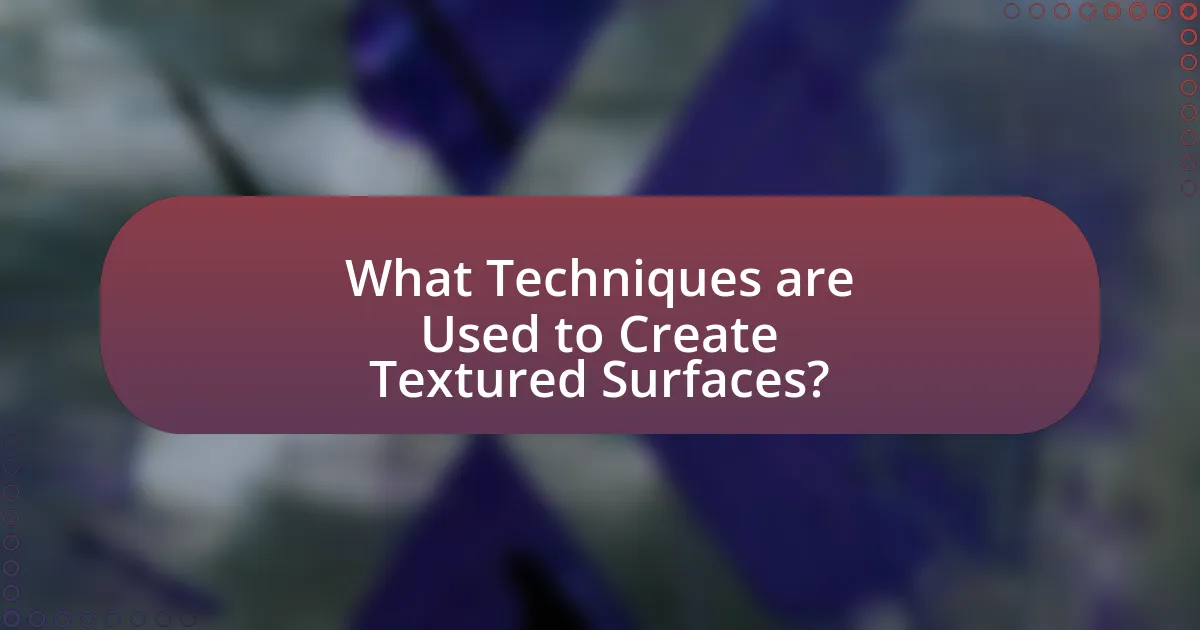
What Techniques are Used to Create Textured Surfaces?
Techniques used to create textured surfaces include layering, impasto, and the use of mixed materials. Layering involves applying multiple coats of paint or mediums to build depth and texture, while impasto refers to the thick application of paint that creates a three-dimensional effect. Additionally, incorporating materials such as fabric, sand, or paper into the artwork can enhance texture. These methods are widely recognized in mixed media art, as they allow artists to manipulate surface quality and visual interest effectively.
How can artists incorporate different materials for texture?
Artists can incorporate different materials for texture by layering various substances such as fabric, paper, sand, and found objects onto their surfaces. This technique allows for the creation of depth and visual interest, as each material contributes its unique tactile quality. For instance, using coarse materials like sand can add a gritty texture, while smooth fabrics can create contrast. Historical practices in mixed media art, such as those seen in the works of artists like Robert Rauschenberg, demonstrate the effectiveness of combining diverse materials to enhance the sensory experience of the artwork.
What types of materials are commonly used for creating texture?
Common materials used for creating texture include fabric, paper, sand, and modeling paste. Fabric adds depth and tactile quality, while paper can be layered or torn for varied effects. Sand provides a gritty texture, and modeling paste allows for three-dimensional applications. These materials are frequently utilized in mixed media art to enhance visual interest and dimensionality, as evidenced by their widespread use in various artistic practices.
How do different materials affect the final appearance of the artwork?
Different materials significantly influence the final appearance of artwork by altering texture, color, and overall visual impact. For instance, the use of acrylic paints can create vibrant colors and a glossy finish, while oil paints offer a rich depth and a slower drying time that allows for blending. Additionally, incorporating materials like sand or fabric can add physical texture, enhancing the tactile quality of the piece. Research indicates that the choice of medium can also affect light reflection; for example, matte surfaces absorb light, creating a softer look, whereas glossy surfaces reflect light, resulting in a more dynamic appearance. Thus, the selection of materials is crucial in determining the aesthetic qualities of mixed media art.
What methods can be employed to apply texture in mixed media?
Various methods can be employed to apply texture in mixed media, including layering materials, using texture paste, and incorporating found objects. Layering materials, such as paper, fabric, or paint, creates depth and visual interest by adding dimension to the artwork. Texture paste, which can be applied with tools like palette knives or brushes, allows artists to create raised surfaces that enhance tactile qualities. Additionally, incorporating found objects, such as sand, beads, or natural materials, introduces unique textures and can evoke specific themes or emotions in the artwork. These methods are widely recognized in mixed media practices, as they effectively transform flat surfaces into dynamic compositions.
How does layering contribute to texture creation?
Layering significantly contributes to texture creation by adding depth and complexity to the surface of mixed media art. Each layer introduces different materials, colors, and techniques, which interact to create varied tactile and visual effects. For instance, applying a base layer of paint followed by textured mediums like gels or pastes can result in a rich, multidimensional surface. This method is supported by the practice of artists who utilize layering to enhance the sensory experience of their work, as seen in the techniques of mixed media pioneers like Robert Rauschenberg, who famously combined paint with found objects to create intricate textures.
What techniques can be used for manipulating surfaces?
Techniques for manipulating surfaces include layering, embossing, and applying texture mediums. Layering involves building up materials to create depth, while embossing uses pressure to create raised designs on surfaces. Texture mediums, such as gels and pastes, can be applied to add dimension and tactile quality to the artwork. These techniques are commonly utilized in mixed media art to enhance visual interest and engage the viewer’s sense of touch.
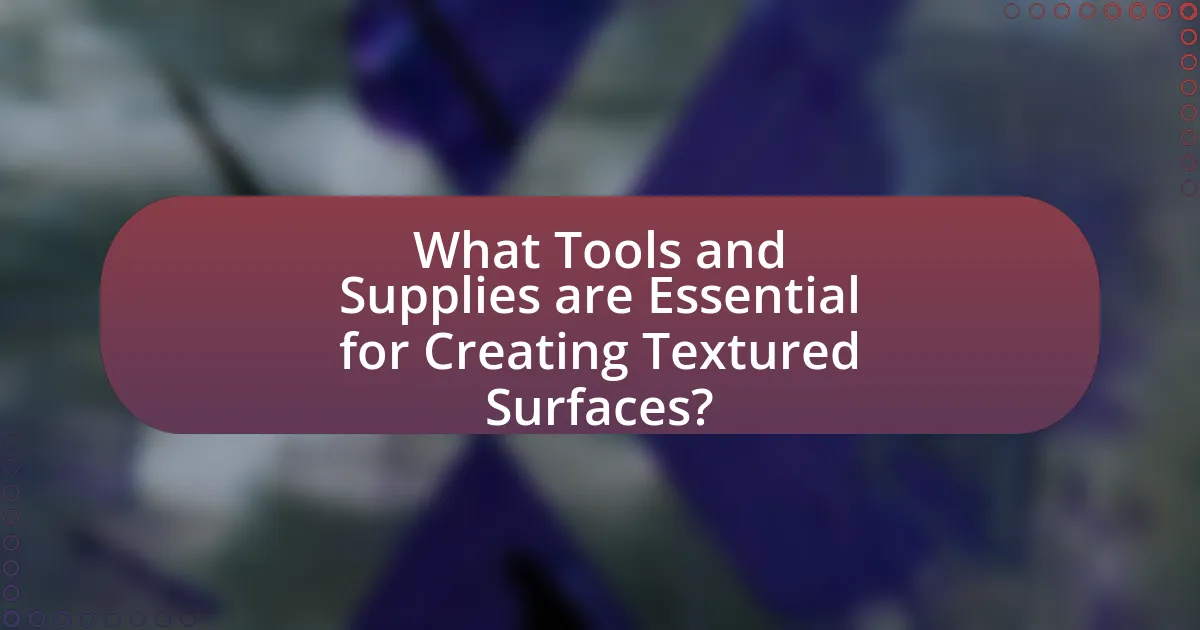
What Tools and Supplies are Essential for Creating Textured Surfaces?
Essential tools and supplies for creating textured surfaces include palette knives, texture paste, sponges, and various brushes. Palette knives allow for the application of thick materials and can create distinct patterns. Texture paste, often acrylic-based, adds dimension and can be manipulated with tools for varied effects. Sponges are useful for dabbing and creating organic textures, while different brushes can apply paint or mediums in ways that enhance surface interest. These tools are widely recognized in mixed media art for their effectiveness in achieving diverse textures.
What basic tools do artists need for texture creation?
Artists need a variety of basic tools for texture creation, including palette knives, brushes, sponges, and various types of modeling paste. Palette knives allow for the application of thick materials and can create sharp lines and edges, while brushes are essential for blending and applying paint in different textures. Sponges can be used to create soft, organic textures, and modeling paste can add dimension and depth to surfaces. These tools are fundamental in mixed media art, enabling artists to experiment with different techniques and achieve diverse textural effects.
How do different tools affect the texture outcome?
Different tools significantly influence the texture outcome in mixed media art by altering the application method and material interaction. For instance, brushes create smooth, blended textures, while palette knives produce sharp, defined edges and thicker applications. Additionally, tools like sponges can introduce a porous, uneven texture, enhancing depth and dimension. Research indicates that the choice of tool directly impacts the visual and tactile qualities of the artwork, as evidenced by studies showing that varying application techniques can lead to distinct surface characteristics, such as the difference between a soft, feathered edge from a brush versus a rugged, impasto effect from a knife.
What are some specialized tools for advanced texture techniques?
Some specialized tools for advanced texture techniques include palette knives, texture rollers, and silicone molds. Palette knives allow artists to create varied textures by manipulating paint or other mediums, while texture rollers can imprint patterns onto surfaces, enhancing depth and interest. Silicone molds enable the reproduction of intricate designs, providing consistent texture across multiple pieces. These tools are essential for achieving complex textures in mixed media art, as they facilitate the layering and application of materials in innovative ways.
What supplies are recommended for mixed media artists?
Mixed media artists are recommended to use a variety of supplies including acrylic paints, watercolor, pastels, inks, and collage materials such as paper and fabric. These supplies allow for the creation of textured surfaces, which is essential in mixed media art. Additionally, tools like brushes, palette knives, and sponges enhance the application techniques, while adhesives and gels help in layering different materials effectively. The versatility of these supplies supports the exploration of various artistic expressions and techniques, making them fundamental for mixed media artists.
How do various paints and mediums contribute to texture?
Various paints and mediums contribute to texture by altering the surface quality and visual depth of artwork. For instance, acrylic paints can be thickened with gels or pastes, creating a raised texture that adds dimension. Oil paints, when mixed with mediums like linseed oil, can achieve a smooth or impasto finish, enhancing the tactile experience. Watercolor paints, while typically flat, can be layered or combined with salt or alcohol to create unique textures through reactions on the paper. Additionally, mediums such as modeling paste or texture gels can be applied under or over paint layers to introduce varied surface characteristics. These techniques are widely recognized in mixed media art, where the interplay of different materials enhances the overall aesthetic and sensory impact of the piece.
What are the best adhesives for mixed media texture applications?
The best adhesives for mixed media texture applications include PVA glue, gel medium, and hot glue. PVA glue, known for its versatility and strong bond, is ideal for paper and porous materials. Gel medium provides a thick, clear adhesive that enhances texture and can be used with various surfaces, including canvas and wood. Hot glue offers a quick-setting option that works well for heavier materials and three-dimensional elements. These adhesives are widely used by artists for their effectiveness in creating durable and textured surfaces in mixed media art.
What are some best practices for creating textured surfaces in mixed media art?
To create textured surfaces in mixed media art, artists should layer materials such as acrylic gels, modeling paste, and found objects. Layering these materials allows for depth and complexity, enhancing the visual interest of the artwork. For instance, using a palette knife to apply modeling paste can create raised textures, while incorporating sand or fabric can add tactile elements. Additionally, artists should experiment with different tools, such as brushes, sponges, or even their fingers, to manipulate the texture effectively. This approach is supported by the fact that varied textures can evoke emotional responses and draw viewers into the artwork, as noted in studies on visual perception in art.
